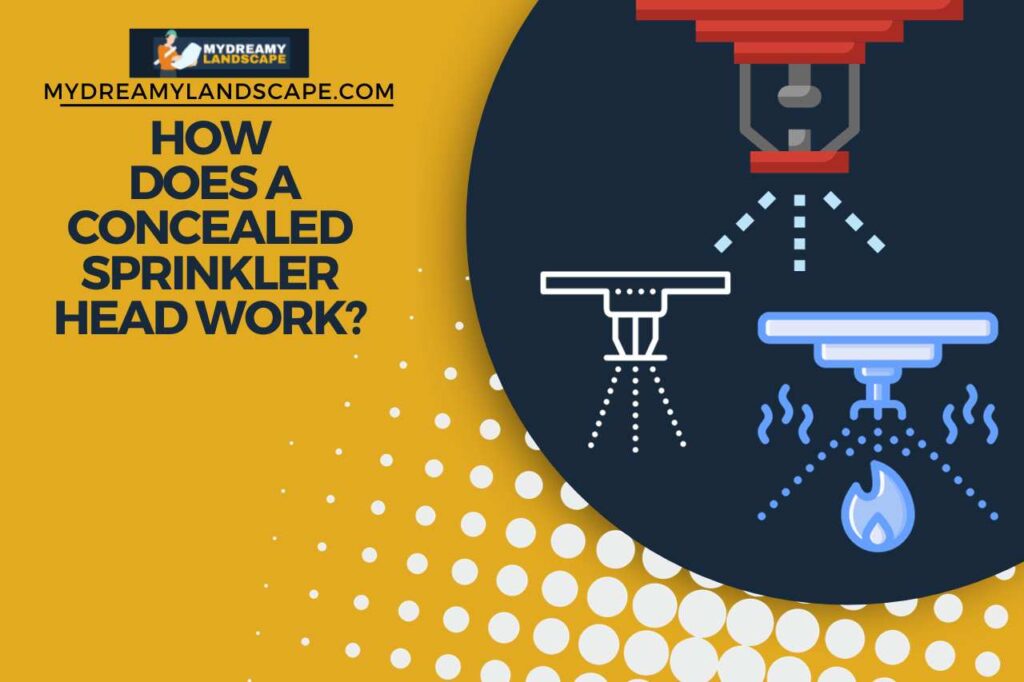Wondering “how does a concealed sprinkler head work”? You’re not alone! These sleek sprinklers are the perfect blend of safety and style, fitting right into modern interiors without a hitch. We’ve unpacked everything you need to know – from the subtle distinctions between exposed and concealed sprinklers to their benefits and drawbacks. So, if you’re mulling over which one’s right for your space, or simply curious, keep reading. Let’s demystify these discreet defenders together!
What is a Concealed Sprinkler Head?
The concealed sprinkler head is a type of fire sprinkler that hides behind a decorative plate when not activated. Unlike traditional, exposed sprinklers, this design offers a seamless look, integrating smoothly with a building’s interior aesthetics.
- Design & Functionality: These sprinkler heads feature a flat cover plate, which is flush with the ceiling, concealing the actual sprinkler nozzle beneath.
- Activation: When exposed to a certain temperature, typically from a fire, the cover plate drops away, revealing the sprinkler, which then releases water to suppress the fire.
- Benefits: Ideal for spaces prioritizing design, concealed heads offer protection without compromising aesthetics. Plus, they maintain the same safety standards as other sprinklers.
How does a Concealed Sprinkler Head Work?
The way a concealed sprinkler head operates is by staying hidden behind a decorative plate until a specified heat triggers it. Upon sensing the elevated temperature, often from a fire, the plate descends, enabling the sprinkler to discharge water.
- Concealment: A primary trait of these sprinkler heads is the decorative cover plate, providing a refined look. This plate is temperature-sensitive and sits flush against the ceiling, masking the sprinkler beneath.
- Temperature Sensitivity: Each concealed head contains a temperature-sensitive element, such as a glass bulb filled with a colored liquid. This element ensures the system remains dormant unless a genuine threat is detected.
- Activation Sequence:
- Step 1: As room temperature rises due to a fire, the liquid inside the glass bulb expands.
- Step 2: Upon reaching a predetermined temperature, the bulb shatters, causing the cover plate’s soldered link to break.
- Step 3: The plate drops, revealing the sprinkler.
- Step 4: With the obstruction gone, water sprays in a predetermined pattern, dousing the flames.
- Efficiency: Designed for both function and form, concealed sprinkler heads effectively suppress fires while maintaining the room’s aesthetic appeal.
Pros and Cons of Concealed Sprinkler Heads
The pros and cons of concealed sprinkler heads revolve around their design, functionality, and aesthetic appeal. While they seamlessly integrate into building interiors, it’s essential to consider both their advantages and limitations before installation.
Pros
- Aesthetic Appeal: Concealed sprinklers offer a cleaner, unobtrusive look. Their decorative plates ensure a smooth and continuous ceiling line, enhancing a room’s overall design.
- Same Efficiency as Standard Heads: Despite their sleek appearance, they don’t compromise on performance. These heads provide fire protection equivalent to traditional, exposed sprinklers.
- Reduction in Accidental Activations: Due to their concealed design, there’s a decreased likelihood of them getting accidentally bumped or tampered with.
- Versatility: They can be installed in various settings where aesthetics are a priority, from upscale offices to luxurious residences.
Cons
- Cost: Generally, concealed heads tend to be more expensive than their exposed counterparts, potentially raising overall installation costs.
- Maintenance Access: The decorative plate can sometimes make routine inspections and maintenance slightly more challenging, requiring extra steps to ensure everything is functioning correctly.
- Replacement: If one gets damaged, finding a matching plate or design might be difficult, especially if the model has been phased out or if a specific décor match is required.
Who Should Opt for Concealed Sprinkler Heads?
Individuals or entities prioritizing aesthetics without compromising safety should consider concealed sprinkler heads. These fixtures are perfect for spaces where the visual appeal is as vital as fire protection.
- Upscale Establishments: High-end hotels, restaurants, and retail spaces can benefit from a seamless ceiling appearance.
- Modern Offices: Workspaces aiming for a contemporary, sleek design will find these sprinklers ideal.
- Residential Interiors: Homeowners desiring a polished look, especially in luxury homes or condos, might prefer these concealed units.
Exposed vs Concealed Sprinkler Heads; How they Work?
In comparing exposed and concealed sprinkler heads, the fundamental difference lies in their design and visibility. Exposed heads remain visible at all times, while concealed units stay hidden until activated by heat.
Exposed Sprinkler Heads
- Visibility: These are always in plain sight, directly mounted to the piping system.
- Activation: Contains a heat-sensitive element, usually a glass bulb or fusible link. Upon reaching its designated temperature, it activates, discharging water.
Concealed Sprinkler Heads
- Aesthetics: Concealed by a decorative plate, these sprinklers offer a seamless appearance.
- Activation Sequence: The heat-sensitive plate drops away when a specific temperature is met, revealing the sprinkler which then releases water.
While both types aim to suppress fires effectively, the choice between them hinges on aesthetic preferences and the intended ambiance of the space. It’s vital to balance design considerations with fire safety functionality.
Watch this one,
Video Credits – FireAlarmDude5967
You May Also Like

